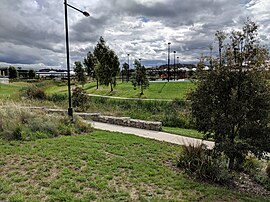Googong
|
Googong Queanbeyan, New South Wales |
|||||||||||||||
|---|---|---|---|---|---|---|---|---|---|---|---|---|---|---|---|
 |
|||||||||||||||
| Coordinates | 35°26′S 149°13′E / 35.433°S 149.217°ECoordinates: 35°26′S 149°13′E / 35.433°S 149.217°E | ||||||||||||||
| Population | 2,690 (2016 census) | ||||||||||||||
| Location | 10 km (6 mi) S of Queanbeyan | ||||||||||||||
| LGA(s) | Queanbeyan–Palerang Regional Council | ||||||||||||||
| County | Murray | ||||||||||||||
| Parish | Googong | ||||||||||||||
| State electorate(s) | Monaro | ||||||||||||||
| Federal Division(s) | Eden-Monaro | ||||||||||||||
|
|||||||||||||||
Googong is a suburb of Queanbeyan–Palerang Regional Council located to the south of Queanbeyan.
Googong contains the developed areas of Fernleigh Park, Little Burra, Googong Township and Mount Campbell Estate. It borders Jerrabomberra and Karabar on the north and Environa on the west. It is about 10 kilometres (6.2 mi) south of the Queanbeyan central business district.
Googong is located in the Monaro district of New South Wales. There are five Indigenous groups that have identified a connection to the area. The area also has a long history of European farming and settlement. The township is named after one of the largest farming properties in the area although the meaning and origins of the word Googong remain obscure.
The first part of the original stone homestead was built in 1845 and was first occupied by Alexander McDonald, an employee of the Campbell family who were early settlers of the Canberra region. The homestead was later renamed ‘Beltana’. The area around Googong Township has a number of historic features including the old London Bridge Homestead and the London Bridge Arch, a remarkable natural limestone bridge formed by Burra Creek over thousands of years. The nearby Googong Dam, fed by the Queanbeyan River and numerous creeks, is by far the largest in the ACT region. It was constructed in 1977.
Googong Foreshores is the name given to the area around Googong Dam. This is separate from the town of Googong and is managed as a water catchment, wildlife refuge and public recreation area. Park Care volunteers help to protect the national and cultural values of the Foreshores.
Planning for the Googong site began in the early 2000s, with approval to begin the re-zoning process granted in 2006. The findings of the Independent Queanbeyan Land Release Inquiry, issued by the NSW Minister for Planning in September of that year recommended the site as the future residential growth area for the City of Queanbeyan. In November 2007, the NSW Department of Planning issued a Section 65 certificate enabling the public exhibition of the draft Local Environmental Plan which was available for public comment until February 2008. The re-zoning of the site to allow residential development was approved in December 2009.
At that time it was announced that Googong will have five neighbourhoods, a town centre and four local shopping centres, as well as 183 hectares of open space to provide recreational, ecological and visual amenity. As part of the project, the developers undertook a Voluntary Planning Agreement to dedicate land and undertake construction works valued at over $300 million. These included road and intersection upgrades on local access roads and the construction of community facilities including a library, community centre, indoor sports and aquatic centre, sporting fields and open spaces and a neighbourhood clubhouses containing an indoor swimming pool, tennis courts, gym and meeting rooms. The Development Control Plan for the township of Googong was approved by Queanbeyan City Council in October 2010. The final plan was formally adopted in June 2013. Civil construction commenced at Googong in 2012 with the first residents moving in in February 2014.
...
Wikipedia

